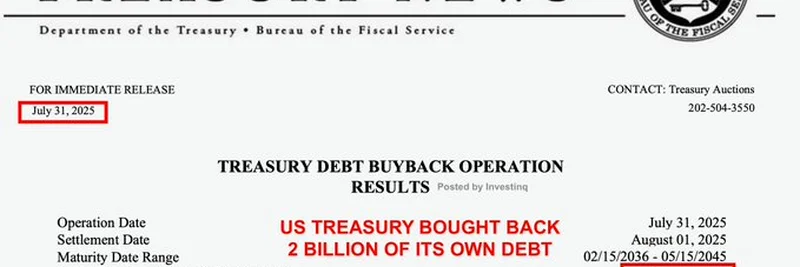Ever wondered what happens when the U.S. Treasury decides to buy back its own debt? On July 31, 2025, they quietly pulled off a $2 billion operation that’s got financial experts buzzing. Posted by StockMarket.News @_Investinq, this move might just be the smartest financial play of the year—and most people missed it! Let’s break it down in a way that’s easy to digest, even if you’re new to the world of finance.
What’s a Debt Buyback, Anyway?
Think of it like the Treasury cleaning out its old closet. They issued bonds (basically IOUs) years ago, promising to pay back investors with interest. Some of these bonds, especially the long-term ones maturing between 2036 and 2045, aren’t as popular anymore because interest rates have shot up. So, the Treasury stepped in to repurchase $2 billion of these older bonds from Wall Street dealers. It’s a way to manage debt and keep the financial system steady.
Why Buy Back Now?
The Treasury didn’t just pick any bonds. They targeted ones trading at big discounts—meaning they bought them for less than their original $100 face value. For example, a 2.375% bond due in 2042 was snagged for $72.15, and a 2.750% bond due in 2042 went for $82.02. Why? These older bonds pay lower interest compared to today’s rates (around 5% for short-term T-bills), so investors are willing to sell them cheap. The Treasury saw a chance to save money long-term and reduce market stress.
The Bigger Picture: Stabilizing the Market
This isn’t just about saving a few bucks. With global uncertainties like trade wars and inflation, long-term interest rates could spike if too many investors try to dump these bonds. By buying back $2 billion, the Treasury acts like a safety net, preventing a market panic. It’s a smart move to anchor long-term rates without making a big public fuss—some call it “stealth yield curve control.”
How Did They Pull It Off?
The process was a reverse auction, where Wall Street dealers offered to sell $19.7 billion in bonds, but the Treasury only accepted $2 billion of the best deals. They likely paid for this using cash reserves or by issuing short-term T-bills, which cost more now due to higher interest rates. It’s a trade-off: higher short-term costs for lower long-term risks.
What’s Next?
This isn’t a one-time thing. The Treasury plans to double its buyback operations to four per quarter, making it a regular tool to manage debt. With foreign investors like China and Japan selling off U.S. bonds, and the Federal Reserve pulling back, this could be a quiet way to keep the market stable. Plus, they saved about $370 million by buying at a discount—nice bonus!
Why Should You Care?
If you’re into meme tokens or blockchain, you might wonder how this connects. Well, stable financial markets mean a healthier environment for crypto investments. A spike in long-term rates could shake things up, affecting everything from borrowing costs to investor confidence. Keeping an eye on these buybacks could give you an edge in predicting market trends.
Final Thoughts
This $2 billion buyback might seem small, but it’s a strategic move with big implications. It’s like the Treasury saying, “We’ve got this under control.” Whether you’re a finance geek or just curious, this is a story worth watching. Follow StockMarket.News @_Investinq for more insights, and let us know your thoughts in the comments!
Want to stay ahead of the curve? Sign up for our newsletter at meme-insider.com to get the latest on meme tokens, blockchain, and more!



